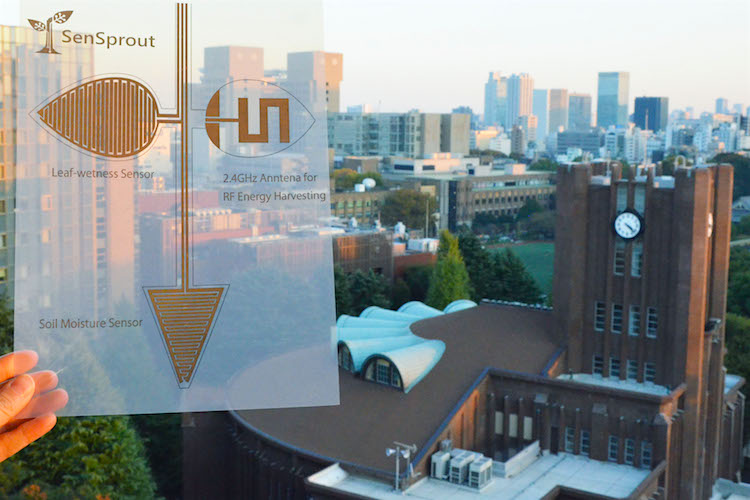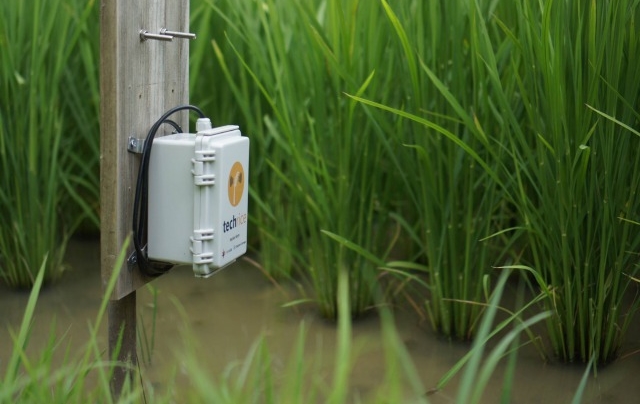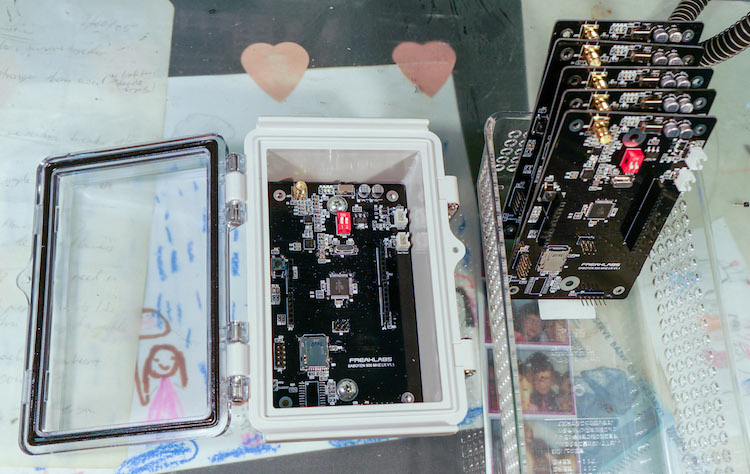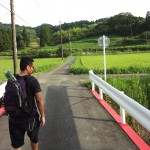Sensprout and Techrice, Japanese prototypes for agriculture
Published 16 November 2015 by Cherise Fong
In Japan, where traditional agricultural practices are aging fast, research looks toward connected solutions. Using environmental sensors, Sensprout and Techrice are two rising projects by hackers, entrepreneurs and researchers in Tokyo.
Tokyo, from our correspondent
Sensprout: paper sensors and antenna
“The less humans, the better.” This bold statement by Tung Ta, master student researcher at Tokyo University working on the Sensprout project, refers to the current tendency in Japanese farmlands. According to his colleague, Ryo Shigeta, PhD student researcher, farmers of all generations are increasingly attracted to environmental sensors and collaboration with technology, in order to facilitate, optimize and eventually automate their own work. Engineers are excited by the new challenge of designing wireless sensor systems, while venture companies are investing more in this competitive market. Not to mention subsidies from the government, which is all the more interested in developing the agricultural sector and monitoring production.
Presentation of Sensprout:
Buoyed by its recent success on Indiegogo and at SXSW Interactive (thanks to the Todai to Texas initiative), the Sensprout start-up aims to offer a comprehensive data monitoring and visualization system for anyone from green thumbs to professional farmers. But its real innovation lies in its sensors and antenna—made of paper.
Of course, this isn’t just any paper, or any ink. The “instant inkjet circuit” technology was invented by Professor Yoshihiro Kawahara, Sensprout’s initiator and technical advisor, who also launched in parallel the dedicated start-up AgIC. The technology allows people to print (or even draw with a pen and erase) circuits using special ink and paper, which are compatible with a normal inkjet printer.
Applied to the paper Sensprout sensor, urban farmers can print at home the silver circuit, which currently features a leaf-wetness sensor, a soil-moisture sensor and a 2.4 Ghz antenna (for RF energy harvesting).

The system operates with a Texas Instruments MSP microcontroller, a capacitor and a recycled Android smartphone to log and send data. After delivering the product to their 138 crowdfunders (who contributed a total of $169,931), they plan to print the circuits on copper pipes so that the Sensprout sensors can be deployed on the scale of professional farmlands.
Techrice: sensor network for rice paddies

“The more of the hardware we ‘own’, the more flexible we can make the system,” affirms Halfdan Rump, developer and project manager of Techrice. Initiated by renowned circuit designer, IoT expert and local personality Akiba, the man behind the Freaklabs webshop and Hacker Farm community, Techrice is the archetype of a project that is entirely open, designed and developed from human resources, locally implemented and realized for the common good (of agriculture, food, the environment…).
As Akiba explains, in the rural area of Kamogawa in Chiba, most farmers, especially rice farmers, are older people who don’t necessarily live near their fields. Yet rice paddies in particular require meticulous daily monitoring in order to maintain a constant water level, just below the level that would prevent the seedlings from growing, but just above the level that would allow them to be invaded by weeds. This technique—intensive, ancient and still current—is known as continuous flooding.

Techrice is a box, sturdy and waterproof, that encloses a customized Arduino circuit, to which are connected sensors to measure temperature, humidity and water level. The system is powered by solar panels, logs data on an SD card, connects to the Cloud via 3G (ubiquitous in Japan) and uses sonar to take measures that are accurate to less than a centimeter, without contact. All the code, of course, is available on Github. The small but dedicated team is now looking for collaborators in order to develop the project, optimize and implement it beyond its native land.
“Finding collaborators was initially difficult,” says Halfdan, “but once the project started getting some publicity, people have been writing because they’re interested in doing something together. An example of that is Michael Stenta from FarmOS, which is a web-based farm management tool. We’re agreeing that it makes a lot of sense to integrate Techrice and FarmOS. Another upcoming collaboration is with Sensprout. They have designed printable moisture sensors and water-level sensors. For them it’s good to have their sensors field tested as much as possible, and for us it’s good to explore new and cheap sensor types. I also intend to take Techrice to Farm Hack and see what they have to say about it.”
To dig deeper, read Akiba’s article on Hackaday, which explains in detail the technology of Techrice

